Analysis of the Government’s Alcohol Strategy: Formulation Process
VerifiedAdded on 2023/06/14
|12
|3749
|236
Report
AI Summary
This report provides an in-depth analysis of the Government's Alcohol Strategy, focusing on its formulation process, objectives, and socio-economic context. It examines the issue of increasing alcohol consumption rates and the government's agenda in addressing this problem. The report outlines the main policy objectives, including reducing alcohol-fueled violence and minimizing harmful alcohol consumption. It further discusses the aspects relevant to the formulation process, such as the stakeholders involved and the evidence that underpins the debate. The report also includes a theoretical reflection on the process of framing and formulating the policy, considering social, economic, and political factors. The analysis highlights the impact of alcohol on communities, healthcare, and the economy, concluding with a discussion of the policy's effectiveness and implications. Desklib provides access to this document and many other solved assignments for students.
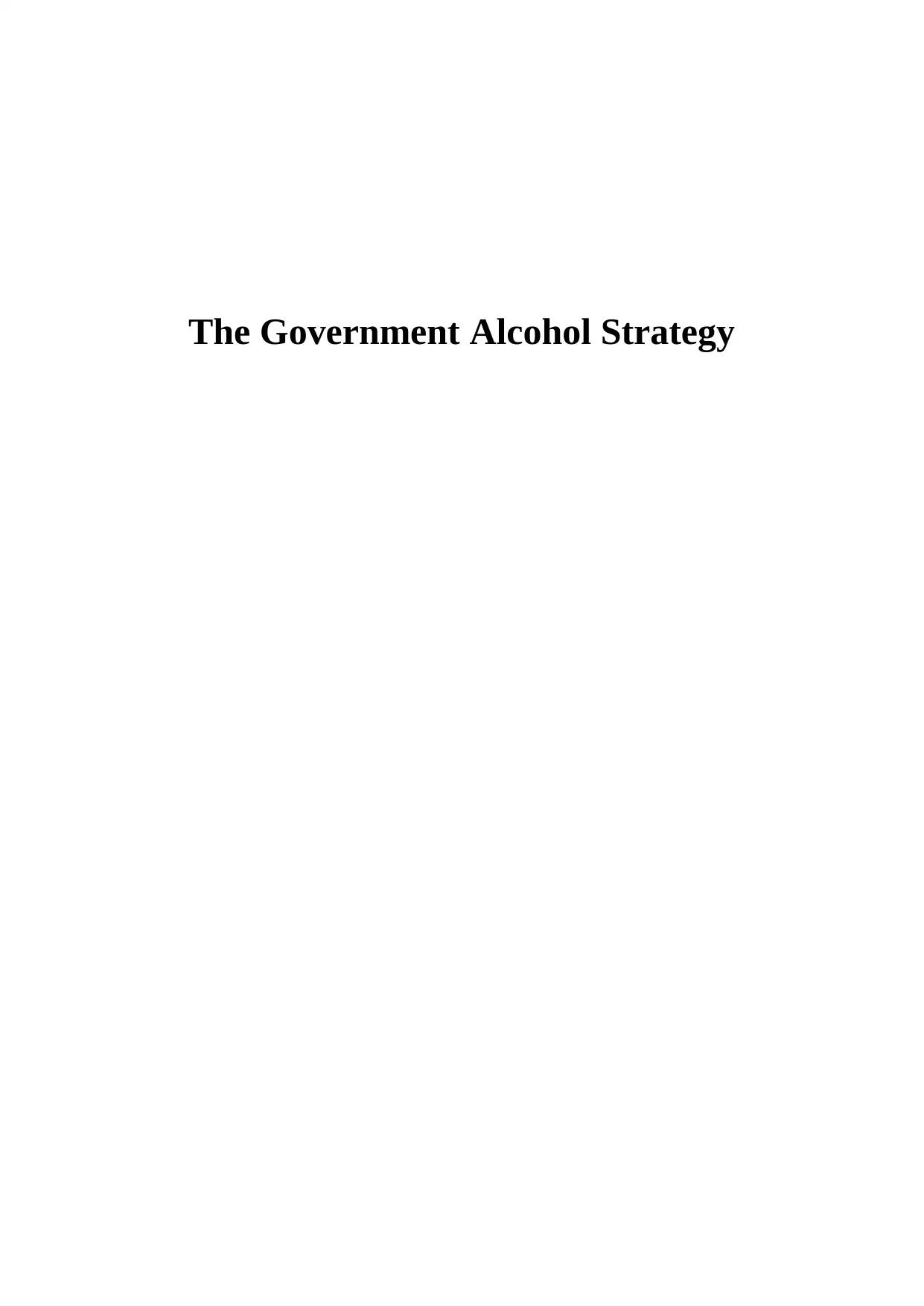
The Government Alcohol Strategy
Paraphrase This Document
Need a fresh take? Get an instant paraphrase of this document with our AI Paraphraser
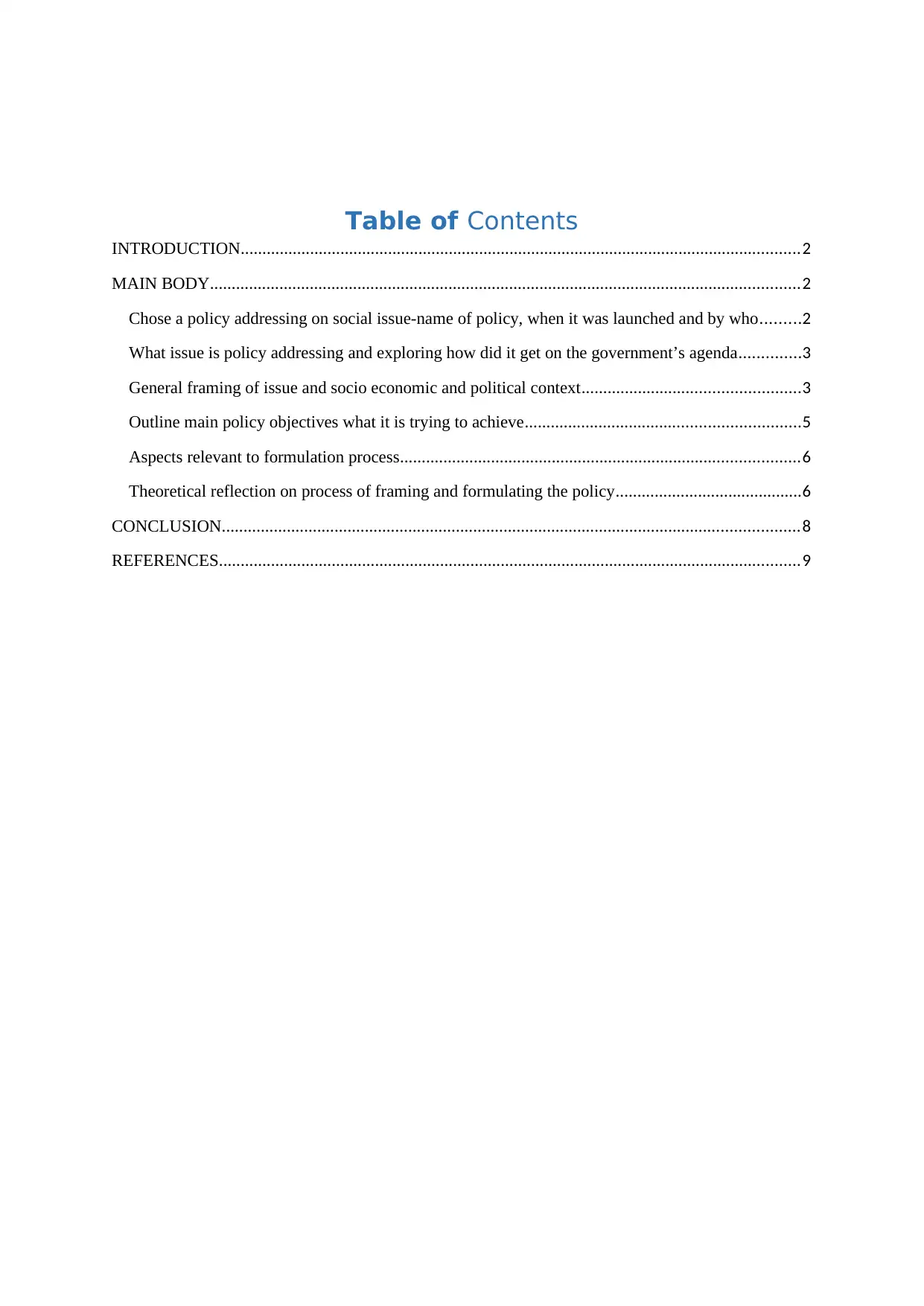
Table of Contents
INTRODUCTION.................................................................................................................................2
MAIN BODY........................................................................................................................................2
Chose a policy addressing on social issue-name of policy, when it was launched and by who.........2
What issue is policy addressing and exploring how did it get on the government’s agenda..............3
General framing of issue and socio economic and political context..................................................3
Outline main policy objectives what it is trying to achieve...............................................................5
Aspects relevant to formulation process............................................................................................6
Theoretical reflection on process of framing and formulating the policy...........................................6
CONCLUSION.....................................................................................................................................8
REFERENCES......................................................................................................................................9
INTRODUCTION.................................................................................................................................2
MAIN BODY........................................................................................................................................2
Chose a policy addressing on social issue-name of policy, when it was launched and by who.........2
What issue is policy addressing and exploring how did it get on the government’s agenda..............3
General framing of issue and socio economic and political context..................................................3
Outline main policy objectives what it is trying to achieve...............................................................5
Aspects relevant to formulation process............................................................................................6
Theoretical reflection on process of framing and formulating the policy...........................................6
CONCLUSION.....................................................................................................................................8
REFERENCES......................................................................................................................................9
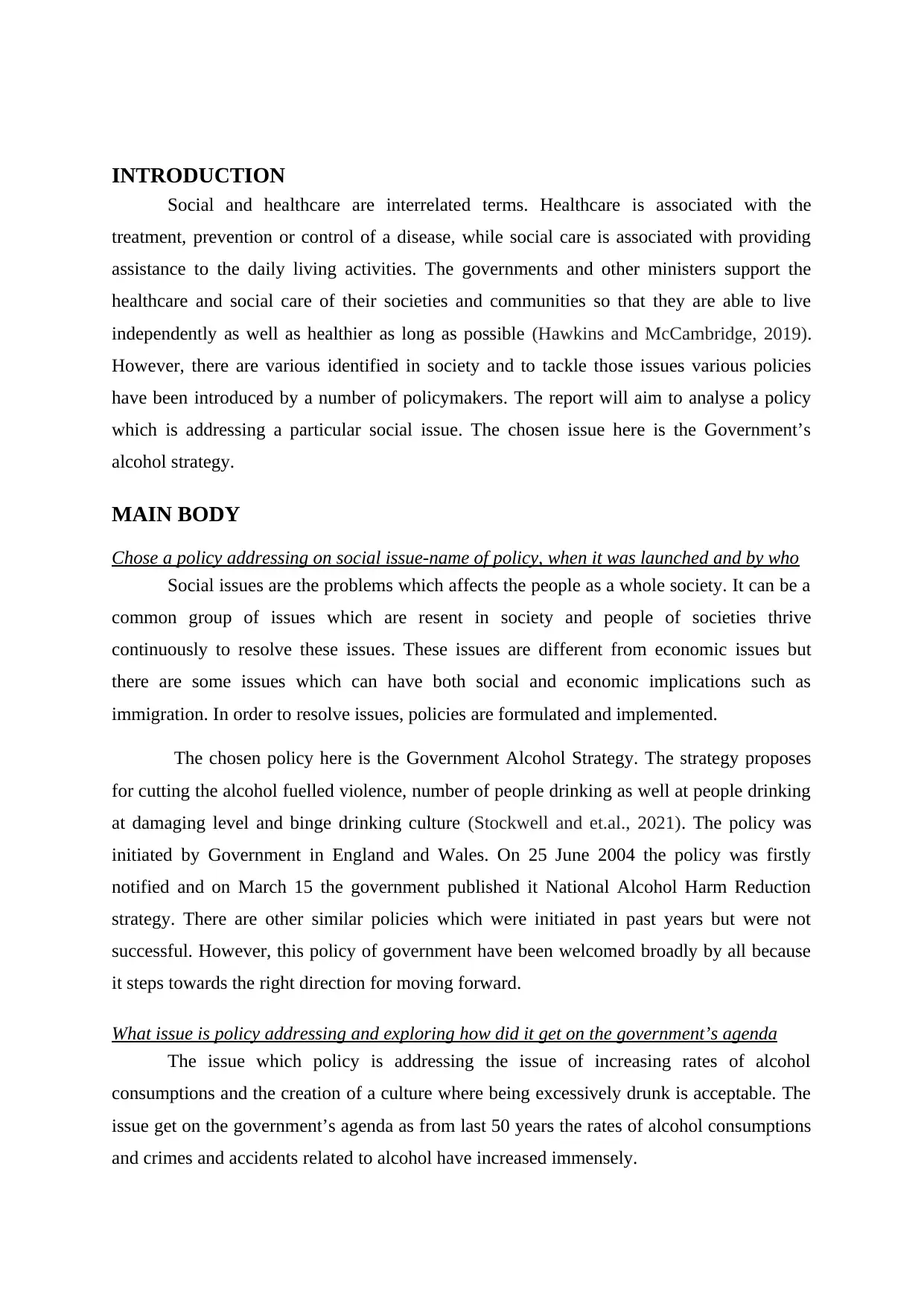
INTRODUCTION
Social and healthcare are interrelated terms. Healthcare is associated with the
treatment, prevention or control of a disease, while social care is associated with providing
assistance to the daily living activities. The governments and other ministers support the
healthcare and social care of their societies and communities so that they are able to live
independently as well as healthier as long as possible (Hawkins and McCambridge, 2019).
However, there are various identified in society and to tackle those issues various policies
have been introduced by a number of policymakers. The report will aim to analyse a policy
which is addressing a particular social issue. The chosen issue here is the Government’s
alcohol strategy.
MAIN BODY
Chose a policy addressing on social issue-name of policy, when it was launched and by who
Social issues are the problems which affects the people as a whole society. It can be a
common group of issues which are resent in society and people of societies thrive
continuously to resolve these issues. These issues are different from economic issues but
there are some issues which can have both social and economic implications such as
immigration. In order to resolve issues, policies are formulated and implemented.
The chosen policy here is the Government Alcohol Strategy. The strategy proposes
for cutting the alcohol fuelled violence, number of people drinking as well at people drinking
at damaging level and binge drinking culture (Stockwell and et.al., 2021). The policy was
initiated by Government in England and Wales. On 25 June 2004 the policy was firstly
notified and on March 15 the government published it National Alcohol Harm Reduction
strategy. There are other similar policies which were initiated in past years but were not
successful. However, this policy of government have been welcomed broadly by all because
it steps towards the right direction for moving forward.
What issue is policy addressing and exploring how did it get on the government’s agenda
The issue which policy is addressing the issue of increasing rates of alcohol
consumptions and the creation of a culture where being excessively drunk is acceptable. The
issue get on the government’s agenda as from last 50 years the rates of alcohol consumptions
and crimes and accidents related to alcohol have increased immensely.
Social and healthcare are interrelated terms. Healthcare is associated with the
treatment, prevention or control of a disease, while social care is associated with providing
assistance to the daily living activities. The governments and other ministers support the
healthcare and social care of their societies and communities so that they are able to live
independently as well as healthier as long as possible (Hawkins and McCambridge, 2019).
However, there are various identified in society and to tackle those issues various policies
have been introduced by a number of policymakers. The report will aim to analyse a policy
which is addressing a particular social issue. The chosen issue here is the Government’s
alcohol strategy.
MAIN BODY
Chose a policy addressing on social issue-name of policy, when it was launched and by who
Social issues are the problems which affects the people as a whole society. It can be a
common group of issues which are resent in society and people of societies thrive
continuously to resolve these issues. These issues are different from economic issues but
there are some issues which can have both social and economic implications such as
immigration. In order to resolve issues, policies are formulated and implemented.
The chosen policy here is the Government Alcohol Strategy. The strategy proposes
for cutting the alcohol fuelled violence, number of people drinking as well at people drinking
at damaging level and binge drinking culture (Stockwell and et.al., 2021). The policy was
initiated by Government in England and Wales. On 25 June 2004 the policy was firstly
notified and on March 15 the government published it National Alcohol Harm Reduction
strategy. There are other similar policies which were initiated in past years but were not
successful. However, this policy of government have been welcomed broadly by all because
it steps towards the right direction for moving forward.
What issue is policy addressing and exploring how did it get on the government’s agenda
The issue which policy is addressing the issue of increasing rates of alcohol
consumptions and the creation of a culture where being excessively drunk is acceptable. The
issue get on the government’s agenda as from last 50 years the rates of alcohol consumptions
and crimes and accidents related to alcohol have increased immensely.
⊘ This is a preview!⊘
Do you want full access?
Subscribe today to unlock all pages.

Trusted by 1+ million students worldwide
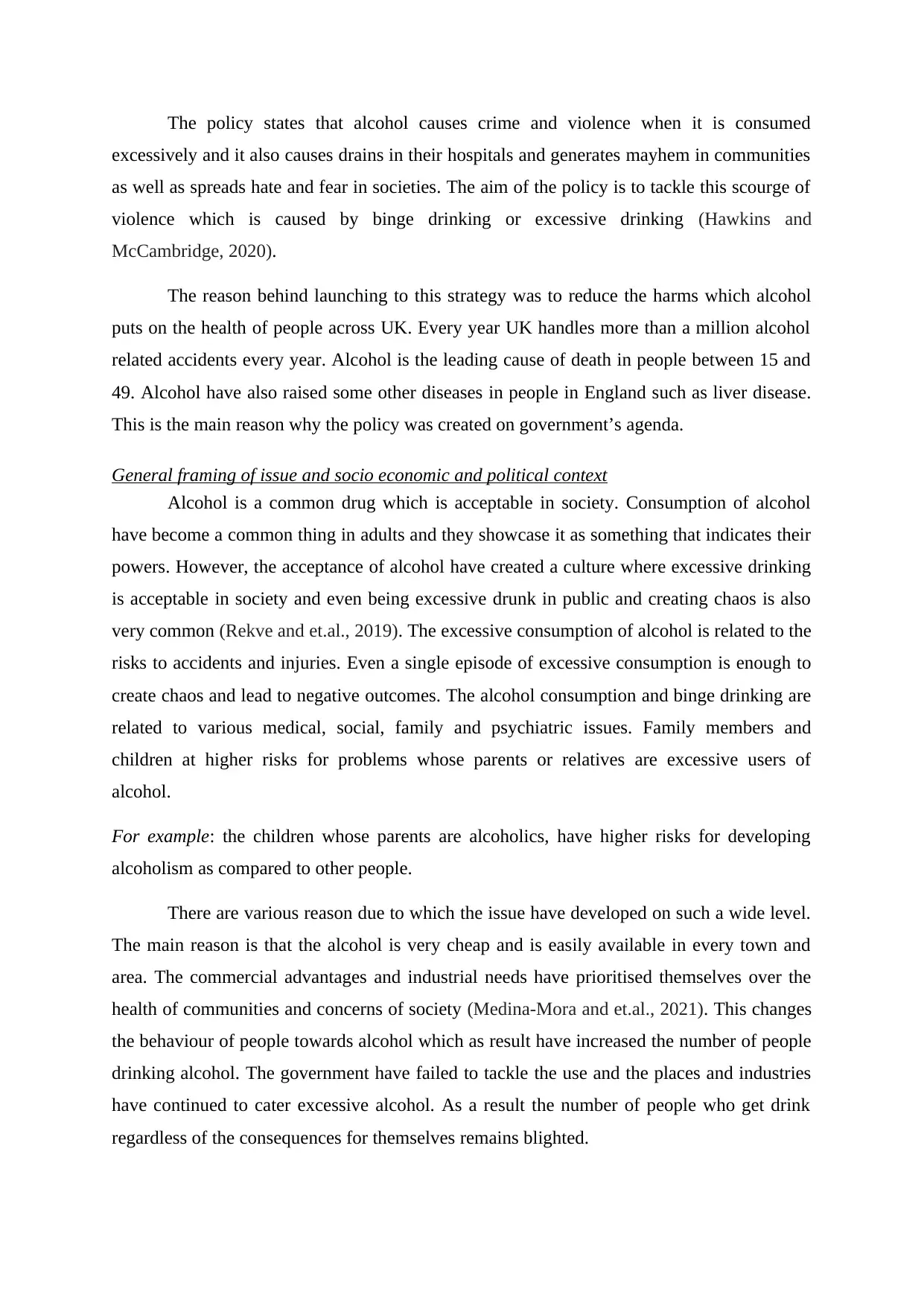
The policy states that alcohol causes crime and violence when it is consumed
excessively and it also causes drains in their hospitals and generates mayhem in communities
as well as spreads hate and fear in societies. The aim of the policy is to tackle this scourge of
violence which is caused by binge drinking or excessive drinking (Hawkins and
McCambridge, 2020).
The reason behind launching to this strategy was to reduce the harms which alcohol
puts on the health of people across UK. Every year UK handles more than a million alcohol
related accidents every year. Alcohol is the leading cause of death in people between 15 and
49. Alcohol have also raised some other diseases in people in England such as liver disease.
This is the main reason why the policy was created on government’s agenda.
General framing of issue and socio economic and political context
Alcohol is a common drug which is acceptable in society. Consumption of alcohol
have become a common thing in adults and they showcase it as something that indicates their
powers. However, the acceptance of alcohol have created a culture where excessive drinking
is acceptable in society and even being excessive drunk in public and creating chaos is also
very common (Rekve and et.al., 2019). The excessive consumption of alcohol is related to the
risks to accidents and injuries. Even a single episode of excessive consumption is enough to
create chaos and lead to negative outcomes. The alcohol consumption and binge drinking are
related to various medical, social, family and psychiatric issues. Family members and
children at higher risks for problems whose parents or relatives are excessive users of
alcohol.
For example: the children whose parents are alcoholics, have higher risks for developing
alcoholism as compared to other people.
There are various reason due to which the issue have developed on such a wide level.
The main reason is that the alcohol is very cheap and is easily available in every town and
area. The commercial advantages and industrial needs have prioritised themselves over the
health of communities and concerns of society (Medina‐Mora and et.al., 2021). This changes
the behaviour of people towards alcohol which as result have increased the number of people
drinking alcohol. The government have failed to tackle the use and the places and industries
have continued to cater excessive alcohol. As a result the number of people who get drink
regardless of the consequences for themselves remains blighted.
excessively and it also causes drains in their hospitals and generates mayhem in communities
as well as spreads hate and fear in societies. The aim of the policy is to tackle this scourge of
violence which is caused by binge drinking or excessive drinking (Hawkins and
McCambridge, 2020).
The reason behind launching to this strategy was to reduce the harms which alcohol
puts on the health of people across UK. Every year UK handles more than a million alcohol
related accidents every year. Alcohol is the leading cause of death in people between 15 and
49. Alcohol have also raised some other diseases in people in England such as liver disease.
This is the main reason why the policy was created on government’s agenda.
General framing of issue and socio economic and political context
Alcohol is a common drug which is acceptable in society. Consumption of alcohol
have become a common thing in adults and they showcase it as something that indicates their
powers. However, the acceptance of alcohol have created a culture where excessive drinking
is acceptable in society and even being excessive drunk in public and creating chaos is also
very common (Rekve and et.al., 2019). The excessive consumption of alcohol is related to the
risks to accidents and injuries. Even a single episode of excessive consumption is enough to
create chaos and lead to negative outcomes. The alcohol consumption and binge drinking are
related to various medical, social, family and psychiatric issues. Family members and
children at higher risks for problems whose parents or relatives are excessive users of
alcohol.
For example: the children whose parents are alcoholics, have higher risks for developing
alcoholism as compared to other people.
There are various reason due to which the issue have developed on such a wide level.
The main reason is that the alcohol is very cheap and is easily available in every town and
area. The commercial advantages and industrial needs have prioritised themselves over the
health of communities and concerns of society (Medina‐Mora and et.al., 2021). This changes
the behaviour of people towards alcohol which as result have increased the number of people
drinking alcohol. The government have failed to tackle the use and the places and industries
have continued to cater excessive alcohol. As a result the number of people who get drink
regardless of the consequences for themselves remains blighted.
Paraphrase This Document
Need a fresh take? Get an instant paraphrase of this document with our AI Paraphraser
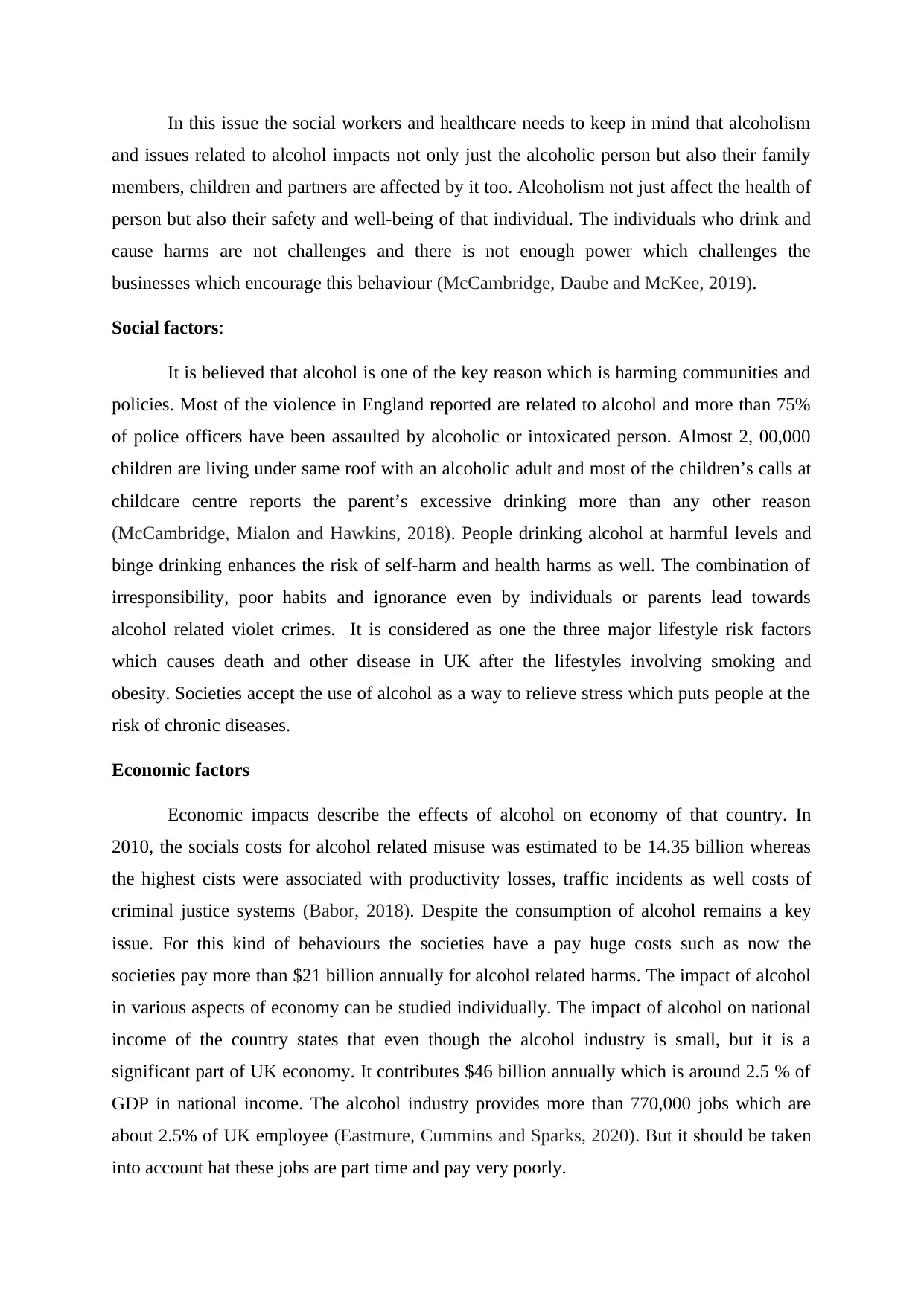
In this issue the social workers and healthcare needs to keep in mind that alcoholism
and issues related to alcohol impacts not only just the alcoholic person but also their family
members, children and partners are affected by it too. Alcoholism not just affect the health of
person but also their safety and well-being of that individual. The individuals who drink and
cause harms are not challenges and there is not enough power which challenges the
businesses which encourage this behaviour (McCambridge, Daube and McKee, 2019).
Social factors:
It is believed that alcohol is one of the key reason which is harming communities and
policies. Most of the violence in England reported are related to alcohol and more than 75%
of police officers have been assaulted by alcoholic or intoxicated person. Almost 2, 00,000
children are living under same roof with an alcoholic adult and most of the children’s calls at
childcare centre reports the parent’s excessive drinking more than any other reason
(McCambridge, Mialon and Hawkins, 2018). People drinking alcohol at harmful levels and
binge drinking enhances the risk of self-harm and health harms as well. The combination of
irresponsibility, poor habits and ignorance even by individuals or parents lead towards
alcohol related violet crimes. It is considered as one the three major lifestyle risk factors
which causes death and other disease in UK after the lifestyles involving smoking and
obesity. Societies accept the use of alcohol as a way to relieve stress which puts people at the
risk of chronic diseases.
Economic factors
Economic impacts describe the effects of alcohol on economy of that country. In
2010, the socials costs for alcohol related misuse was estimated to be 14.35 billion whereas
the highest cists were associated with productivity losses, traffic incidents as well costs of
criminal justice systems (Babor, 2018). Despite the consumption of alcohol remains a key
issue. For this kind of behaviours the societies have a pay huge costs such as now the
societies pay more than $21 billion annually for alcohol related harms. The impact of alcohol
in various aspects of economy can be studied individually. The impact of alcohol on national
income of the country states that even though the alcohol industry is small, but it is a
significant part of UK economy. It contributes $46 billion annually which is around 2.5 % of
GDP in national income. The alcohol industry provides more than 770,000 jobs which are
about 2.5% of UK employee (Eastmure, Cummins and Sparks, 2020). But it should be taken
into account hat these jobs are part time and pay very poorly.
and issues related to alcohol impacts not only just the alcoholic person but also their family
members, children and partners are affected by it too. Alcoholism not just affect the health of
person but also their safety and well-being of that individual. The individuals who drink and
cause harms are not challenges and there is not enough power which challenges the
businesses which encourage this behaviour (McCambridge, Daube and McKee, 2019).
Social factors:
It is believed that alcohol is one of the key reason which is harming communities and
policies. Most of the violence in England reported are related to alcohol and more than 75%
of police officers have been assaulted by alcoholic or intoxicated person. Almost 2, 00,000
children are living under same roof with an alcoholic adult and most of the children’s calls at
childcare centre reports the parent’s excessive drinking more than any other reason
(McCambridge, Mialon and Hawkins, 2018). People drinking alcohol at harmful levels and
binge drinking enhances the risk of self-harm and health harms as well. The combination of
irresponsibility, poor habits and ignorance even by individuals or parents lead towards
alcohol related violet crimes. It is considered as one the three major lifestyle risk factors
which causes death and other disease in UK after the lifestyles involving smoking and
obesity. Societies accept the use of alcohol as a way to relieve stress which puts people at the
risk of chronic diseases.
Economic factors
Economic impacts describe the effects of alcohol on economy of that country. In
2010, the socials costs for alcohol related misuse was estimated to be 14.35 billion whereas
the highest cists were associated with productivity losses, traffic incidents as well costs of
criminal justice systems (Babor, 2018). Despite the consumption of alcohol remains a key
issue. For this kind of behaviours the societies have a pay huge costs such as now the
societies pay more than $21 billion annually for alcohol related harms. The impact of alcohol
in various aspects of economy can be studied individually. The impact of alcohol on national
income of the country states that even though the alcohol industry is small, but it is a
significant part of UK economy. It contributes $46 billion annually which is around 2.5 % of
GDP in national income. The alcohol industry provides more than 770,000 jobs which are
about 2.5% of UK employee (Eastmure, Cummins and Sparks, 2020). But it should be taken
into account hat these jobs are part time and pay very poorly.
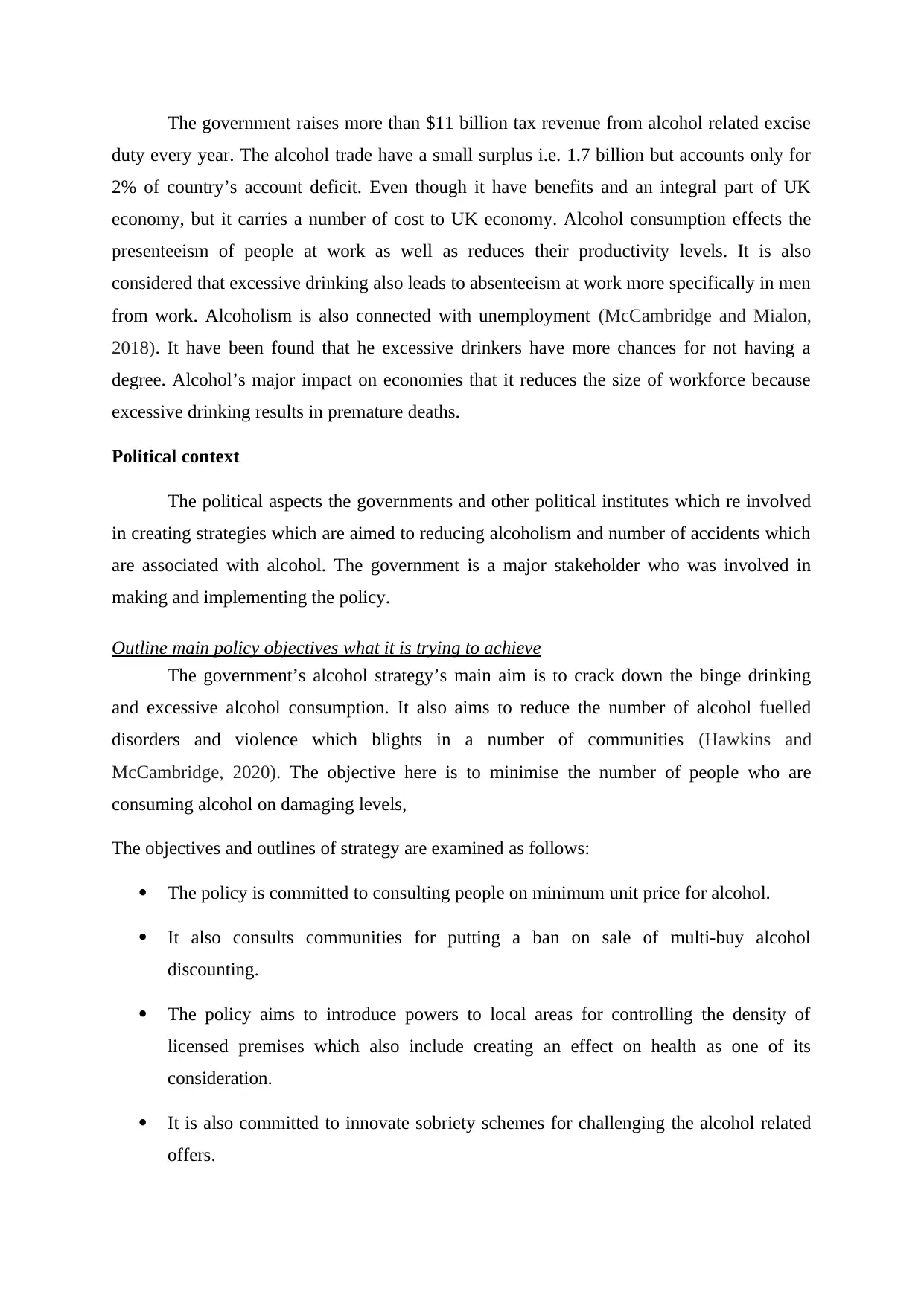
The government raises more than $11 billion tax revenue from alcohol related excise
duty every year. The alcohol trade have a small surplus i.e. 1.7 billion but accounts only for
2% of country’s account deficit. Even though it have benefits and an integral part of UK
economy, but it carries a number of cost to UK economy. Alcohol consumption effects the
presenteeism of people at work as well as reduces their productivity levels. It is also
considered that excessive drinking also leads to absenteeism at work more specifically in men
from work. Alcoholism is also connected with unemployment (McCambridge and Mialon,
2018). It have been found that he excessive drinkers have more chances for not having a
degree. Alcohol’s major impact on economies that it reduces the size of workforce because
excessive drinking results in premature deaths.
Political context
The political aspects the governments and other political institutes which re involved
in creating strategies which are aimed to reducing alcoholism and number of accidents which
are associated with alcohol. The government is a major stakeholder who was involved in
making and implementing the policy.
Outline main policy objectives what it is trying to achieve
The government’s alcohol strategy’s main aim is to crack down the binge drinking
and excessive alcohol consumption. It also aims to reduce the number of alcohol fuelled
disorders and violence which blights in a number of communities (Hawkins and
McCambridge, 2020). The objective here is to minimise the number of people who are
consuming alcohol on damaging levels,
The objectives and outlines of strategy are examined as follows:
The policy is committed to consulting people on minimum unit price for alcohol.
It also consults communities for putting a ban on sale of multi-buy alcohol
discounting.
The policy aims to introduce powers to local areas for controlling the density of
licensed premises which also include creating an effect on health as one of its
consideration.
It is also committed to innovate sobriety schemes for challenging the alcohol related
offers.
duty every year. The alcohol trade have a small surplus i.e. 1.7 billion but accounts only for
2% of country’s account deficit. Even though it have benefits and an integral part of UK
economy, but it carries a number of cost to UK economy. Alcohol consumption effects the
presenteeism of people at work as well as reduces their productivity levels. It is also
considered that excessive drinking also leads to absenteeism at work more specifically in men
from work. Alcoholism is also connected with unemployment (McCambridge and Mialon,
2018). It have been found that he excessive drinkers have more chances for not having a
degree. Alcohol’s major impact on economies that it reduces the size of workforce because
excessive drinking results in premature deaths.
Political context
The political aspects the governments and other political institutes which re involved
in creating strategies which are aimed to reducing alcoholism and number of accidents which
are associated with alcohol. The government is a major stakeholder who was involved in
making and implementing the policy.
Outline main policy objectives what it is trying to achieve
The government’s alcohol strategy’s main aim is to crack down the binge drinking
and excessive alcohol consumption. It also aims to reduce the number of alcohol fuelled
disorders and violence which blights in a number of communities (Hawkins and
McCambridge, 2020). The objective here is to minimise the number of people who are
consuming alcohol on damaging levels,
The objectives and outlines of strategy are examined as follows:
The policy is committed to consulting people on minimum unit price for alcohol.
It also consults communities for putting a ban on sale of multi-buy alcohol
discounting.
The policy aims to introduce powers to local areas for controlling the density of
licensed premises which also include creating an effect on health as one of its
consideration.
It is also committed to innovate sobriety schemes for challenging the alcohol related
offers.
⊘ This is a preview!⊘
Do you want full access?
Subscribe today to unlock all pages.

Trusted by 1+ million students worldwide
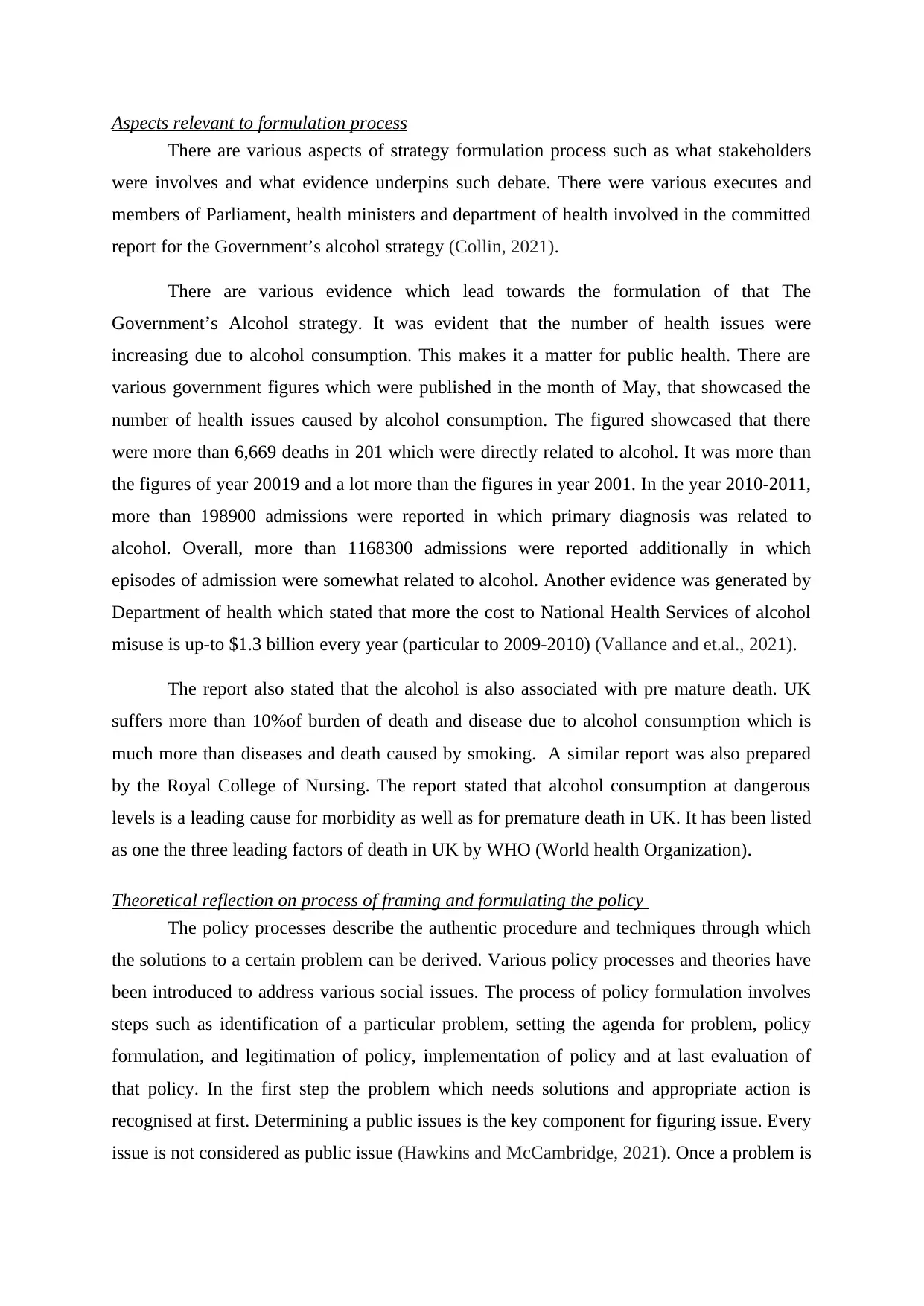
Aspects relevant to formulation process
There are various aspects of strategy formulation process such as what stakeholders
were involves and what evidence underpins such debate. There were various executes and
members of Parliament, health ministers and department of health involved in the committed
report for the Government’s alcohol strategy (Collin, 2021).
There are various evidence which lead towards the formulation of that The
Government’s Alcohol strategy. It was evident that the number of health issues were
increasing due to alcohol consumption. This makes it a matter for public health. There are
various government figures which were published in the month of May, that showcased the
number of health issues caused by alcohol consumption. The figured showcased that there
were more than 6,669 deaths in 201 which were directly related to alcohol. It was more than
the figures of year 20019 and a lot more than the figures in year 2001. In the year 2010-2011,
more than 198900 admissions were reported in which primary diagnosis was related to
alcohol. Overall, more than 1168300 admissions were reported additionally in which
episodes of admission were somewhat related to alcohol. Another evidence was generated by
Department of health which stated that more the cost to National Health Services of alcohol
misuse is up-to $1.3 billion every year (particular to 2009-2010) (Vallance and et.al., 2021).
The report also stated that the alcohol is also associated with pre mature death. UK
suffers more than 10%of burden of death and disease due to alcohol consumption which is
much more than diseases and death caused by smoking. A similar report was also prepared
by the Royal College of Nursing. The report stated that alcohol consumption at dangerous
levels is a leading cause for morbidity as well as for premature death in UK. It has been listed
as one the three leading factors of death in UK by WHO (World health Organization).
Theoretical reflection on process of framing and formulating the policy
The policy processes describe the authentic procedure and techniques through which
the solutions to a certain problem can be derived. Various policy processes and theories have
been introduced to address various social issues. The process of policy formulation involves
steps such as identification of a particular problem, setting the agenda for problem, policy
formulation, and legitimation of policy, implementation of policy and at last evaluation of
that policy. In the first step the problem which needs solutions and appropriate action is
recognised at first. Determining a public issues is the key component for figuring issue. Every
issue is not considered as public issue (Hawkins and McCambridge, 2021). Once a problem is
There are various aspects of strategy formulation process such as what stakeholders
were involves and what evidence underpins such debate. There were various executes and
members of Parliament, health ministers and department of health involved in the committed
report for the Government’s alcohol strategy (Collin, 2021).
There are various evidence which lead towards the formulation of that The
Government’s Alcohol strategy. It was evident that the number of health issues were
increasing due to alcohol consumption. This makes it a matter for public health. There are
various government figures which were published in the month of May, that showcased the
number of health issues caused by alcohol consumption. The figured showcased that there
were more than 6,669 deaths in 201 which were directly related to alcohol. It was more than
the figures of year 20019 and a lot more than the figures in year 2001. In the year 2010-2011,
more than 198900 admissions were reported in which primary diagnosis was related to
alcohol. Overall, more than 1168300 admissions were reported additionally in which
episodes of admission were somewhat related to alcohol. Another evidence was generated by
Department of health which stated that more the cost to National Health Services of alcohol
misuse is up-to $1.3 billion every year (particular to 2009-2010) (Vallance and et.al., 2021).
The report also stated that the alcohol is also associated with pre mature death. UK
suffers more than 10%of burden of death and disease due to alcohol consumption which is
much more than diseases and death caused by smoking. A similar report was also prepared
by the Royal College of Nursing. The report stated that alcohol consumption at dangerous
levels is a leading cause for morbidity as well as for premature death in UK. It has been listed
as one the three leading factors of death in UK by WHO (World health Organization).
Theoretical reflection on process of framing and formulating the policy
The policy processes describe the authentic procedure and techniques through which
the solutions to a certain problem can be derived. Various policy processes and theories have
been introduced to address various social issues. The process of policy formulation involves
steps such as identification of a particular problem, setting the agenda for problem, policy
formulation, and legitimation of policy, implementation of policy and at last evaluation of
that policy. In the first step the problem which needs solutions and appropriate action is
recognised at first. Determining a public issues is the key component for figuring issue. Every
issue is not considered as public issue (Hawkins and McCambridge, 2021). Once a problem is
Paraphrase This Document
Need a fresh take? Get an instant paraphrase of this document with our AI Paraphraser
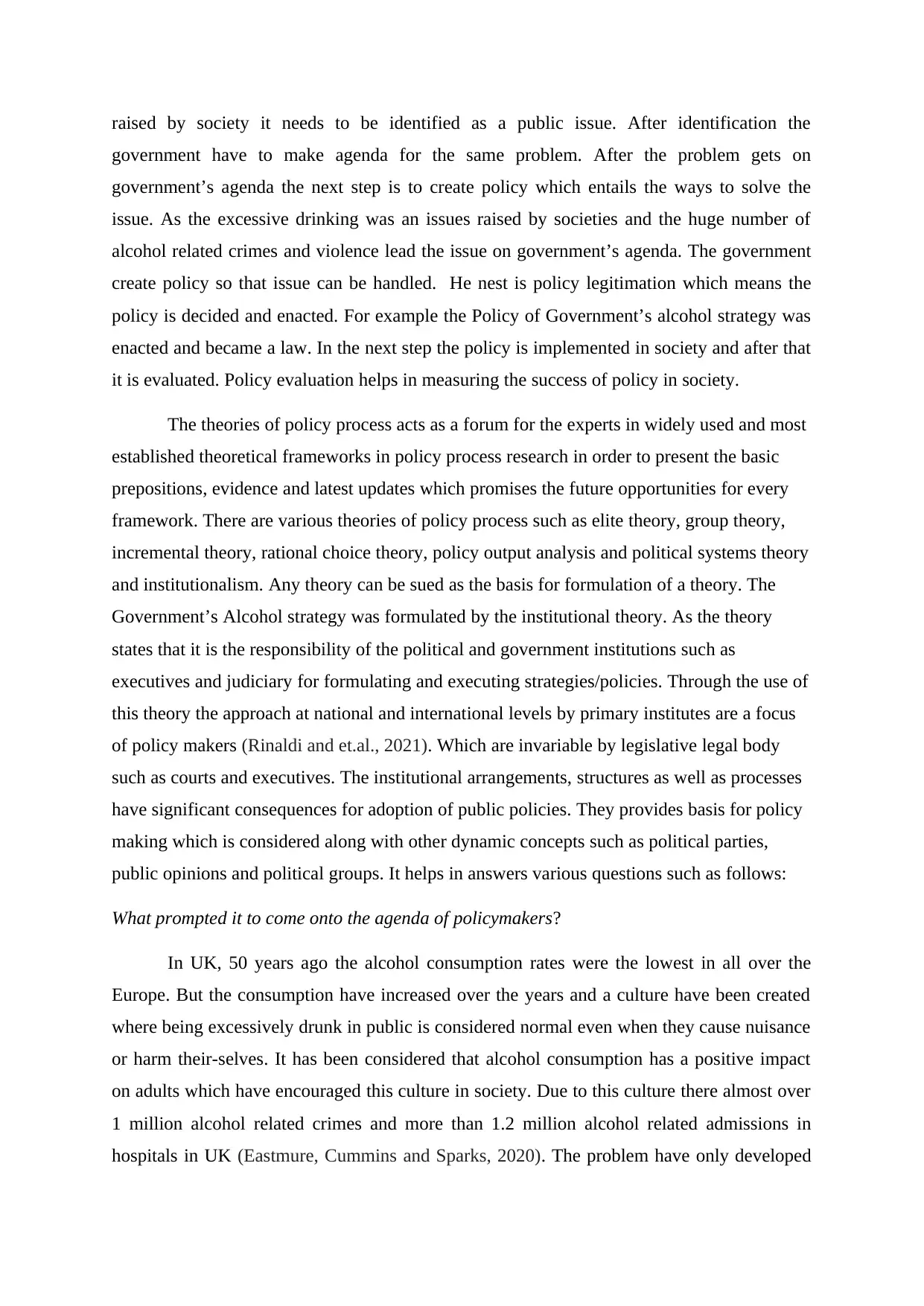
raised by society it needs to be identified as a public issue. After identification the
government have to make agenda for the same problem. After the problem gets on
government’s agenda the next step is to create policy which entails the ways to solve the
issue. As the excessive drinking was an issues raised by societies and the huge number of
alcohol related crimes and violence lead the issue on government’s agenda. The government
create policy so that issue can be handled. He nest is policy legitimation which means the
policy is decided and enacted. For example the Policy of Government’s alcohol strategy was
enacted and became a law. In the next step the policy is implemented in society and after that
it is evaluated. Policy evaluation helps in measuring the success of policy in society.
The theories of policy process acts as a forum for the experts in widely used and most
established theoretical frameworks in policy process research in order to present the basic
prepositions, evidence and latest updates which promises the future opportunities for every
framework. There are various theories of policy process such as elite theory, group theory,
incremental theory, rational choice theory, policy output analysis and political systems theory
and institutionalism. Any theory can be sued as the basis for formulation of a theory. The
Government’s Alcohol strategy was formulated by the institutional theory. As the theory
states that it is the responsibility of the political and government institutions such as
executives and judiciary for formulating and executing strategies/policies. Through the use of
this theory the approach at national and international levels by primary institutes are a focus
of policy makers (Rinaldi and et.al., 2021). Which are invariable by legislative legal body
such as courts and executives. The institutional arrangements, structures as well as processes
have significant consequences for adoption of public policies. They provides basis for policy
making which is considered along with other dynamic concepts such as political parties,
public opinions and political groups. It helps in answers various questions such as follows:
What prompted it to come onto the agenda of policymakers?
In UK, 50 years ago the alcohol consumption rates were the lowest in all over the
Europe. But the consumption have increased over the years and a culture have been created
where being excessively drunk in public is considered normal even when they cause nuisance
or harm their-selves. It has been considered that alcohol consumption has a positive impact
on adults which have encouraged this culture in society. Due to this culture there almost over
1 million alcohol related crimes and more than 1.2 million alcohol related admissions in
hospitals in UK (Eastmure, Cummins and Sparks, 2020). The problem have only developed
government have to make agenda for the same problem. After the problem gets on
government’s agenda the next step is to create policy which entails the ways to solve the
issue. As the excessive drinking was an issues raised by societies and the huge number of
alcohol related crimes and violence lead the issue on government’s agenda. The government
create policy so that issue can be handled. He nest is policy legitimation which means the
policy is decided and enacted. For example the Policy of Government’s alcohol strategy was
enacted and became a law. In the next step the policy is implemented in society and after that
it is evaluated. Policy evaluation helps in measuring the success of policy in society.
The theories of policy process acts as a forum for the experts in widely used and most
established theoretical frameworks in policy process research in order to present the basic
prepositions, evidence and latest updates which promises the future opportunities for every
framework. There are various theories of policy process such as elite theory, group theory,
incremental theory, rational choice theory, policy output analysis and political systems theory
and institutionalism. Any theory can be sued as the basis for formulation of a theory. The
Government’s Alcohol strategy was formulated by the institutional theory. As the theory
states that it is the responsibility of the political and government institutions such as
executives and judiciary for formulating and executing strategies/policies. Through the use of
this theory the approach at national and international levels by primary institutes are a focus
of policy makers (Rinaldi and et.al., 2021). Which are invariable by legislative legal body
such as courts and executives. The institutional arrangements, structures as well as processes
have significant consequences for adoption of public policies. They provides basis for policy
making which is considered along with other dynamic concepts such as political parties,
public opinions and political groups. It helps in answers various questions such as follows:
What prompted it to come onto the agenda of policymakers?
In UK, 50 years ago the alcohol consumption rates were the lowest in all over the
Europe. But the consumption have increased over the years and a culture have been created
where being excessively drunk in public is considered normal even when they cause nuisance
or harm their-selves. It has been considered that alcohol consumption has a positive impact
on adults which have encouraged this culture in society. Due to this culture there almost over
1 million alcohol related crimes and more than 1.2 million alcohol related admissions in
hospitals in UK (Eastmure, Cummins and Sparks, 2020). The problem have only developed
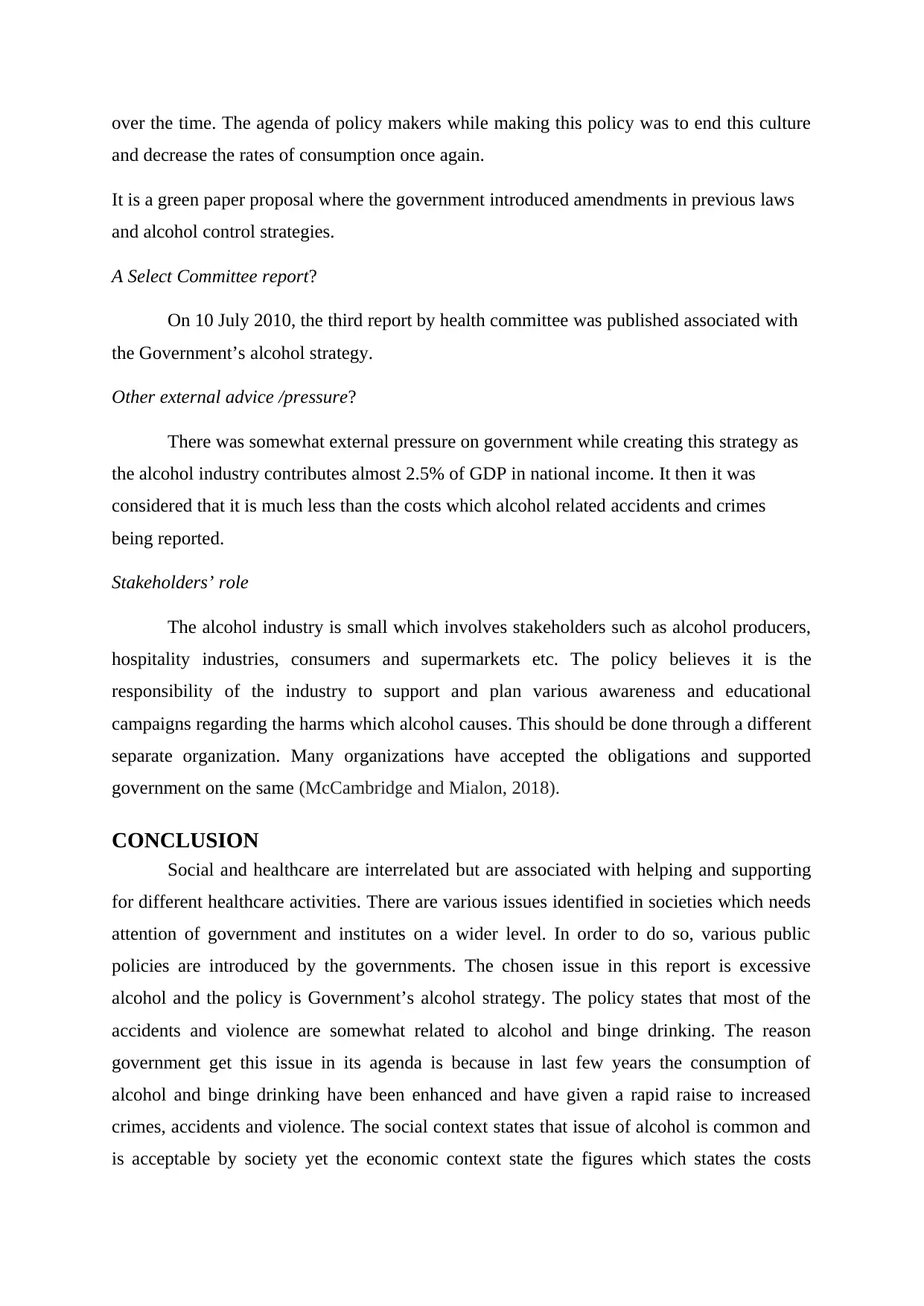
over the time. The agenda of policy makers while making this policy was to end this culture
and decrease the rates of consumption once again.
It is a green paper proposal where the government introduced amendments in previous laws
and alcohol control strategies.
A Select Committee report?
On 10 July 2010, the third report by health committee was published associated with
the Government’s alcohol strategy.
Other external advice /pressure?
There was somewhat external pressure on government while creating this strategy as
the alcohol industry contributes almost 2.5% of GDP in national income. It then it was
considered that it is much less than the costs which alcohol related accidents and crimes
being reported.
Stakeholders’ role
The alcohol industry is small which involves stakeholders such as alcohol producers,
hospitality industries, consumers and supermarkets etc. The policy believes it is the
responsibility of the industry to support and plan various awareness and educational
campaigns regarding the harms which alcohol causes. This should be done through a different
separate organization. Many organizations have accepted the obligations and supported
government on the same (McCambridge and Mialon, 2018).
CONCLUSION
Social and healthcare are interrelated but are associated with helping and supporting
for different healthcare activities. There are various issues identified in societies which needs
attention of government and institutes on a wider level. In order to do so, various public
policies are introduced by the governments. The chosen issue in this report is excessive
alcohol and the policy is Government’s alcohol strategy. The policy states that most of the
accidents and violence are somewhat related to alcohol and binge drinking. The reason
government get this issue in its agenda is because in last few years the consumption of
alcohol and binge drinking have been enhanced and have given a rapid raise to increased
crimes, accidents and violence. The social context states that issue of alcohol is common and
is acceptable by society yet the economic context state the figures which states the costs
and decrease the rates of consumption once again.
It is a green paper proposal where the government introduced amendments in previous laws
and alcohol control strategies.
A Select Committee report?
On 10 July 2010, the third report by health committee was published associated with
the Government’s alcohol strategy.
Other external advice /pressure?
There was somewhat external pressure on government while creating this strategy as
the alcohol industry contributes almost 2.5% of GDP in national income. It then it was
considered that it is much less than the costs which alcohol related accidents and crimes
being reported.
Stakeholders’ role
The alcohol industry is small which involves stakeholders such as alcohol producers,
hospitality industries, consumers and supermarkets etc. The policy believes it is the
responsibility of the industry to support and plan various awareness and educational
campaigns regarding the harms which alcohol causes. This should be done through a different
separate organization. Many organizations have accepted the obligations and supported
government on the same (McCambridge and Mialon, 2018).
CONCLUSION
Social and healthcare are interrelated but are associated with helping and supporting
for different healthcare activities. There are various issues identified in societies which needs
attention of government and institutes on a wider level. In order to do so, various public
policies are introduced by the governments. The chosen issue in this report is excessive
alcohol and the policy is Government’s alcohol strategy. The policy states that most of the
accidents and violence are somewhat related to alcohol and binge drinking. The reason
government get this issue in its agenda is because in last few years the consumption of
alcohol and binge drinking have been enhanced and have given a rapid raise to increased
crimes, accidents and violence. The social context states that issue of alcohol is common and
is acceptable by society yet the economic context state the figures which states the costs
⊘ This is a preview!⊘
Do you want full access?
Subscribe today to unlock all pages.

Trusted by 1+ million students worldwide
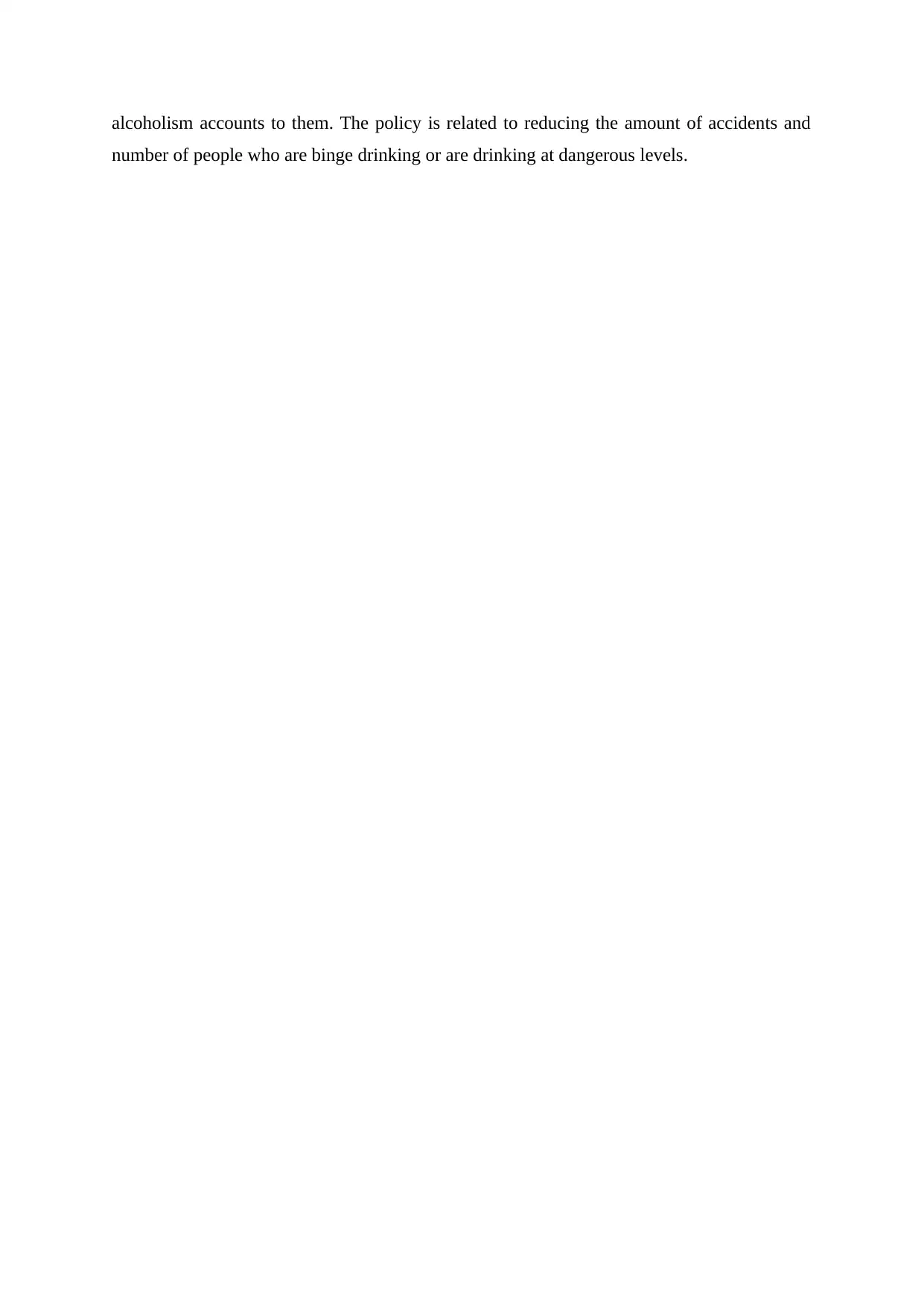
alcoholism accounts to them. The policy is related to reducing the amount of accidents and
number of people who are binge drinking or are drinking at dangerous levels.
number of people who are binge drinking or are drinking at dangerous levels.
Paraphrase This Document
Need a fresh take? Get an instant paraphrase of this document with our AI Paraphraser
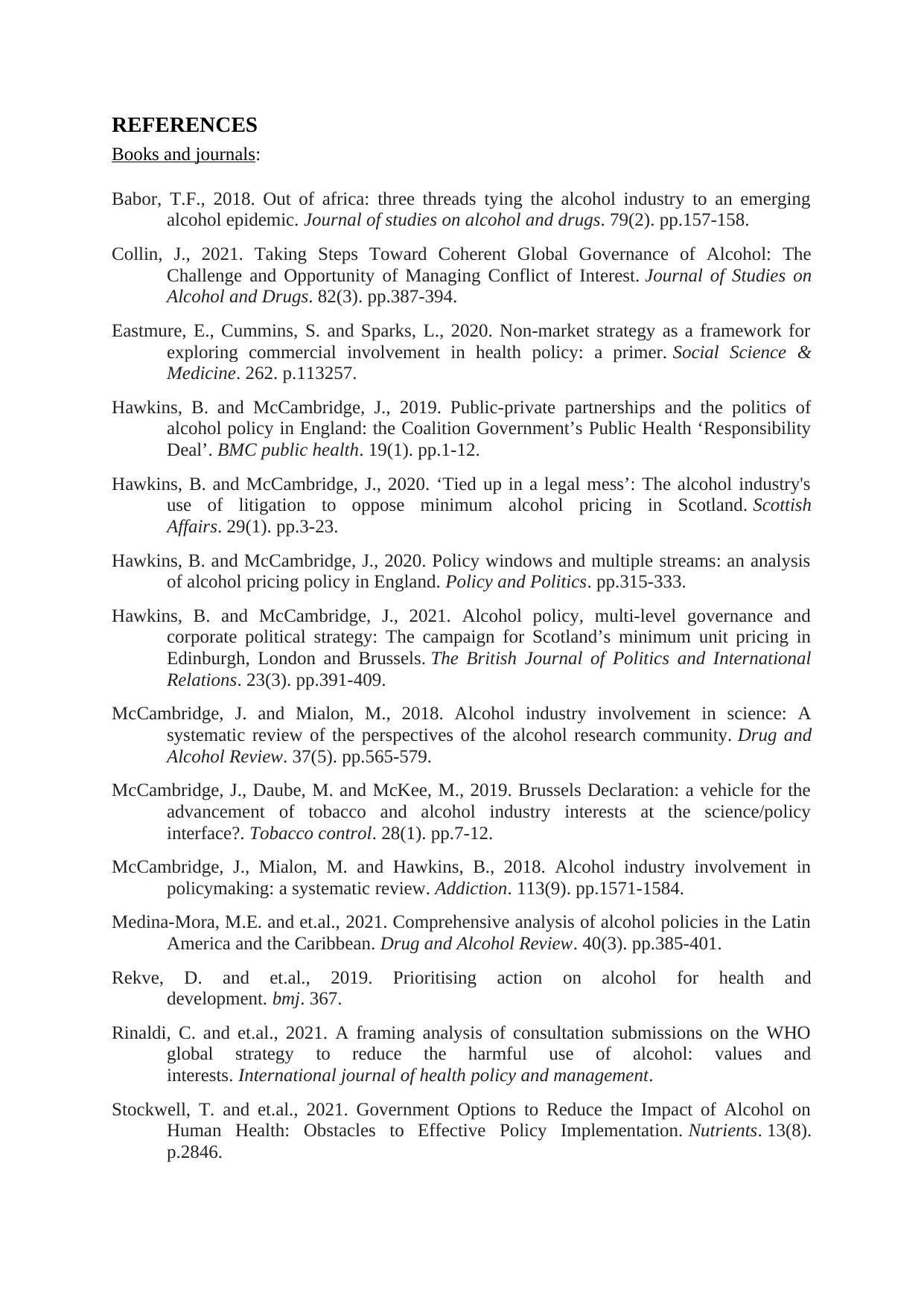
REFERENCES
Books and journals:
Babor, T.F., 2018. Out of africa: three threads tying the alcohol industry to an emerging
alcohol epidemic. Journal of studies on alcohol and drugs. 79(2). pp.157-158.
Collin, J., 2021. Taking Steps Toward Coherent Global Governance of Alcohol: The
Challenge and Opportunity of Managing Conflict of Interest. Journal of Studies on
Alcohol and Drugs. 82(3). pp.387-394.
Eastmure, E., Cummins, S. and Sparks, L., 2020. Non-market strategy as a framework for
exploring commercial involvement in health policy: a primer. Social Science &
Medicine. 262. p.113257.
Hawkins, B. and McCambridge, J., 2019. Public-private partnerships and the politics of
alcohol policy in England: the Coalition Government’s Public Health ‘Responsibility
Deal’. BMC public health. 19(1). pp.1-12.
Hawkins, B. and McCambridge, J., 2020. ‘Tied up in a legal mess’: The alcohol industry's
use of litigation to oppose minimum alcohol pricing in Scotland. Scottish
Affairs. 29(1). pp.3-23.
Hawkins, B. and McCambridge, J., 2020. Policy windows and multiple streams: an analysis
of alcohol pricing policy in England. Policy and Politics. pp.315-333.
Hawkins, B. and McCambridge, J., 2021. Alcohol policy, multi-level governance and
corporate political strategy: The campaign for Scotland’s minimum unit pricing in
Edinburgh, London and Brussels. The British Journal of Politics and International
Relations. 23(3). pp.391-409.
McCambridge, J. and Mialon, M., 2018. Alcohol industry involvement in science: A
systematic review of the perspectives of the alcohol research community. Drug and
Alcohol Review. 37(5). pp.565-579.
McCambridge, J., Daube, M. and McKee, M., 2019. Brussels Declaration: a vehicle for the
advancement of tobacco and alcohol industry interests at the science/policy
interface?. Tobacco control. 28(1). pp.7-12.
McCambridge, J., Mialon, M. and Hawkins, B., 2018. Alcohol industry involvement in
policymaking: a systematic review. Addiction. 113(9). pp.1571-1584.
Medina‐Mora, M.E. and et.al., 2021. Comprehensive analysis of alcohol policies in the Latin
America and the Caribbean. Drug and Alcohol Review. 40(3). pp.385-401.
Rekve, D. and et.al., 2019. Prioritising action on alcohol for health and
development. bmj. 367.
Rinaldi, C. and et.al., 2021. A framing analysis of consultation submissions on the WHO
global strategy to reduce the harmful use of alcohol: values and
interests. International journal of health policy and management.
Stockwell, T. and et.al., 2021. Government Options to Reduce the Impact of Alcohol on
Human Health: Obstacles to Effective Policy Implementation. Nutrients. 13(8).
p.2846.
Books and journals:
Babor, T.F., 2018. Out of africa: three threads tying the alcohol industry to an emerging
alcohol epidemic. Journal of studies on alcohol and drugs. 79(2). pp.157-158.
Collin, J., 2021. Taking Steps Toward Coherent Global Governance of Alcohol: The
Challenge and Opportunity of Managing Conflict of Interest. Journal of Studies on
Alcohol and Drugs. 82(3). pp.387-394.
Eastmure, E., Cummins, S. and Sparks, L., 2020. Non-market strategy as a framework for
exploring commercial involvement in health policy: a primer. Social Science &
Medicine. 262. p.113257.
Hawkins, B. and McCambridge, J., 2019. Public-private partnerships and the politics of
alcohol policy in England: the Coalition Government’s Public Health ‘Responsibility
Deal’. BMC public health. 19(1). pp.1-12.
Hawkins, B. and McCambridge, J., 2020. ‘Tied up in a legal mess’: The alcohol industry's
use of litigation to oppose minimum alcohol pricing in Scotland. Scottish
Affairs. 29(1). pp.3-23.
Hawkins, B. and McCambridge, J., 2020. Policy windows and multiple streams: an analysis
of alcohol pricing policy in England. Policy and Politics. pp.315-333.
Hawkins, B. and McCambridge, J., 2021. Alcohol policy, multi-level governance and
corporate political strategy: The campaign for Scotland’s minimum unit pricing in
Edinburgh, London and Brussels. The British Journal of Politics and International
Relations. 23(3). pp.391-409.
McCambridge, J. and Mialon, M., 2018. Alcohol industry involvement in science: A
systematic review of the perspectives of the alcohol research community. Drug and
Alcohol Review. 37(5). pp.565-579.
McCambridge, J., Daube, M. and McKee, M., 2019. Brussels Declaration: a vehicle for the
advancement of tobacco and alcohol industry interests at the science/policy
interface?. Tobacco control. 28(1). pp.7-12.
McCambridge, J., Mialon, M. and Hawkins, B., 2018. Alcohol industry involvement in
policymaking: a systematic review. Addiction. 113(9). pp.1571-1584.
Medina‐Mora, M.E. and et.al., 2021. Comprehensive analysis of alcohol policies in the Latin
America and the Caribbean. Drug and Alcohol Review. 40(3). pp.385-401.
Rekve, D. and et.al., 2019. Prioritising action on alcohol for health and
development. bmj. 367.
Rinaldi, C. and et.al., 2021. A framing analysis of consultation submissions on the WHO
global strategy to reduce the harmful use of alcohol: values and
interests. International journal of health policy and management.
Stockwell, T. and et.al., 2021. Government Options to Reduce the Impact of Alcohol on
Human Health: Obstacles to Effective Policy Implementation. Nutrients. 13(8).
p.2846.
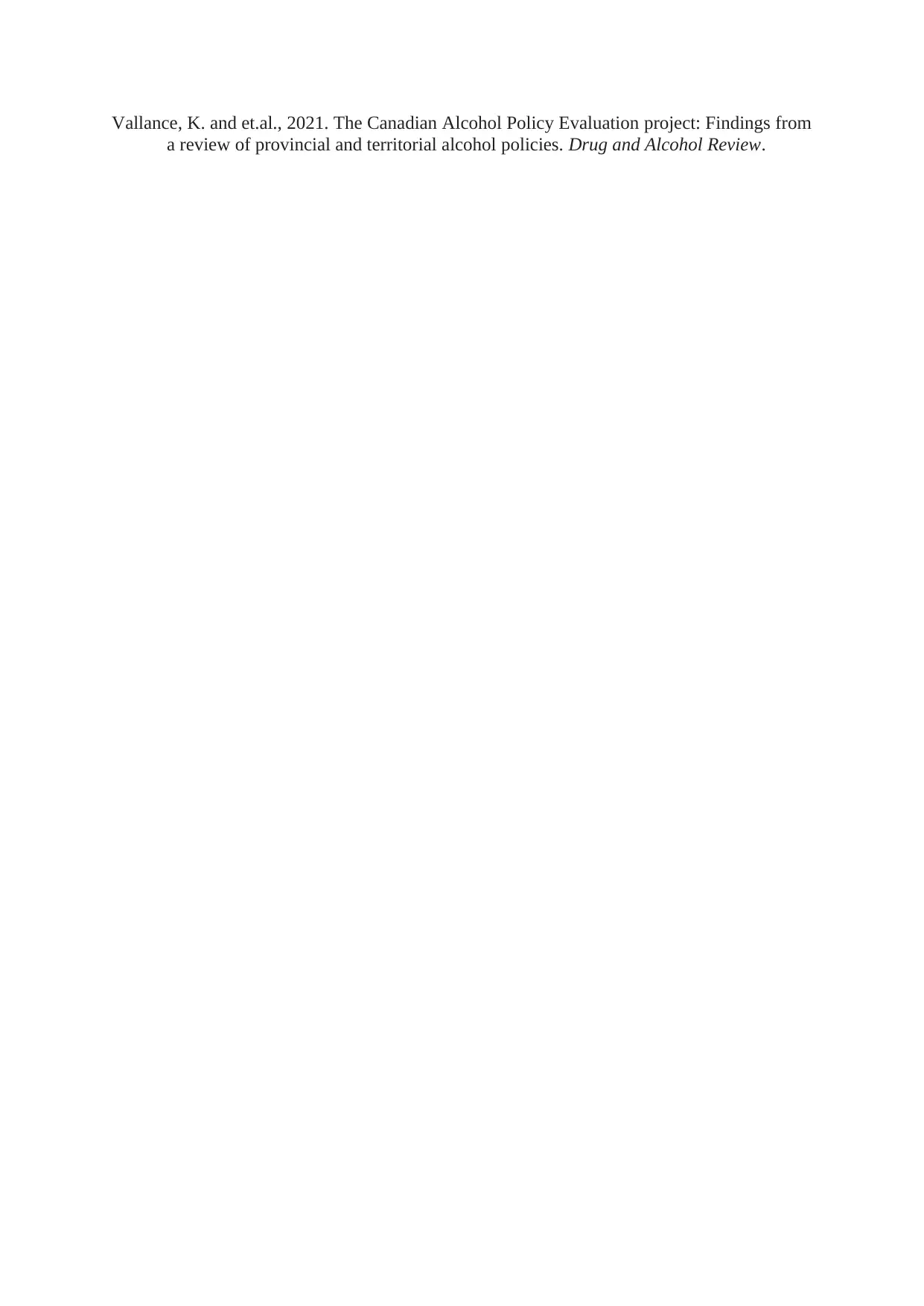
Vallance, K. and et.al., 2021. The Canadian Alcohol Policy Evaluation project: Findings from
a review of provincial and territorial alcohol policies. Drug and Alcohol Review.
a review of provincial and territorial alcohol policies. Drug and Alcohol Review.
⊘ This is a preview!⊘
Do you want full access?
Subscribe today to unlock all pages.

Trusted by 1+ million students worldwide
1 out of 12
Related Documents
Your All-in-One AI-Powered Toolkit for Academic Success.
+13062052269
info@desklib.com
Available 24*7 on WhatsApp / Email
![[object Object]](/_next/static/media/star-bottom.7253800d.svg)
Unlock your academic potential
Copyright © 2020–2025 A2Z Services. All Rights Reserved. Developed and managed by ZUCOL.





